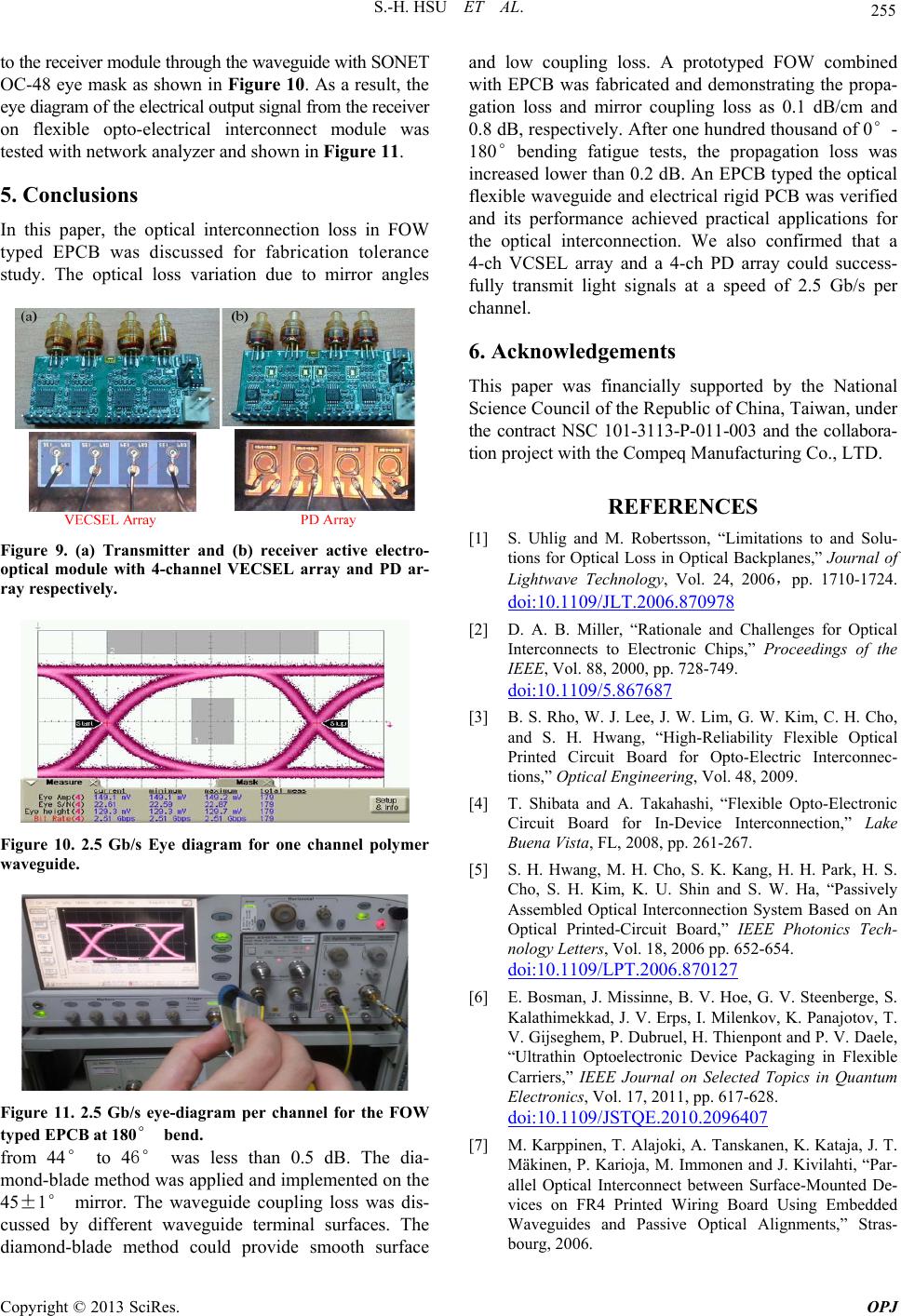
S.-H. HSU ET AL.
Copyright © 2013 SciRes. OPJ
255
to the receiver module through the waveguide with SONET
OC-48 eye mask as shown in Figure 10. As a result, the
eye diagram of the electrical output signal from the receiver
on flexible opto-electrical interconnect module was
tested with network analyzer and shown in Figure 11.
5. Conclusions
In this paper, the optical interconnection loss in FOW
typed EPCB was discussed for fabrication tolerance
study. The optical loss variation due to mirror angles
Figure 9. (a) Transmitter and (b) receiver active electro-
optical module with 4-channel VECSEL array and PD ar-
ray respectively.
Figure 10. 2.5 Gb/s Eye diagram for one channel polymer
waveguide.
Figure 11. 2.5 Gb/s eye-diagram per channel for the FOW
typed EPCB at 180° bend.
from 44° to 46° was less than 0.5 dB. The dia-
mond-blade method was applied and implemented on the
45±1° mirror. The waveguide coupling loss was dis-
cussed by different waveguide terminal surfaces. The
diamond-blade method could provide smooth surface
and low coupling loss. A prototyped FOW combined
with EPCB was fabricated and demonstrating the propa-
gation loss and mirror coupling loss as 0.1 dB/cm and
0.8 dB, respectively. After one hundred thousand of 0°-
180°bending fatigue tests, the propagation loss was
increased lower than 0.2 dB. An EPCB typed the optical
flexible waveguide and electrical rigid PCB was verified
and its performance achieved practical applications for
the optical interconnection. We also confirmed that a
4-ch VCSEL array and a 4-ch PD array could success-
fully transmit light signals at a speed of 2.5 Gb/s per
channel.
6. Acknowledgements
This paper was financially supported by the National
Science Council of the Republic of China, Taiwan, under
the contract NSC 101-3113-P-011-003 and the collabora-
tion project with the Compeq Manufacturing Co., LTD.
REFERENCES
[1] S. Uhlig and M. Robertsson, “Limitations to and Solu-
tions for Optical Loss in Optical Backplanes,” Journal of
Lightwave Technology, Vol. 24, 2006,pp. 1710-1724.
doi:10.1109/JLT.2006.870978
[2] D. A. B. Miller, “Rationale and Challenges for Optical
Interconnects to Electronic Chips,” Proceedings of the
IEEE, Vol. 88, 2000, pp. 728-749.
doi:10.1109/5.867687
[3] B. S. Rho, W. J. Lee, J. W. Lim, G. W. Kim, C. H. Cho,
and S. H. Hwang, “High-Reliability Flexible Optical
Printed Circuit Board for Opto-Electric Interconnec-
tions,” Opti cal Engin eering, Vol. 48, 2009.
[4] T. Shibata and A. Takahashi, “Flexible Opto-Electronic
Circuit Board for In-Device Interconnection,” Lake
Buena Vista, FL, 2008, pp. 261-267.
[5] S. H. Hwang, M. H. Cho, S. K. Kang, H. H. Park, H. S.
Cho, S. H. Kim, K. U. Shin and S. W. Ha, “Passively
Assembled Optical Interconnection System Based on An
Optical Printed-Circuit Board,” IEEE Photonics Tech-
nology Letters, Vol. 18, 2006 pp. 652-654.
doi:10.1109/LPT.2006.87012 7
[6] E. Bosman, J. Missinne, B. V. Hoe, G. V. Steenberge, S.
Kalathimekkad, J. V. Erps, I. Milenkov, K. Panajotov, T.
V. Gijseghem, P. Dubruel, H. Thienpont and P. V. Daele,
“Ultrathin Optoelectronic Device Packaging in Flexible
Carriers,” IEEE Journal on Selected Topics in Quantum
Electronics, Vol. 17, 2011, pp. 617-628.
doi:10.1109/JSTQE.2010.20 96407
[7] M. Karppinen, T. Alajoki, A. Tanskanen, K. Kataja, J. T.
Mäkinen, P. Karioja, M. Immonen and J. Kivilahti, “Par-
allel Optical Interconnect between Surface-Mounted De-
vices on FR4 Printed Wiring Board Using Embedded
Waveguides and Passive Optical Alignments,” Stras-
bourg, 2006.